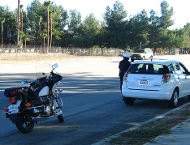California Considers Bill to Shorten Yellow Times
The amount of yellow warning time at California intersections would drop along with speed limits under a bill being considered by the state legislature. The Senate Transportation Committee will hold a hearing Tuesday on Assembly Bill 529, a proposal that re-writes the state’s speed trap law so that cities would be able to round down all speed limits after conducting a traffic study. The measure passed the full Assembly by a 77 to 0 vote on May 19.
Under current law, jurisdictions must set the speed limit at 35 MPH if the study shows traffic is moving at, for example, 34 MPH. The limit must be rounded to the nearest 5 MPH increment. A locality can only reduce the limit to 30 MPH if it can document a specific safety hazard that is not readily apparent to drivers. The proposed legislation would allow municipalities to lower that speed limit to 30 MPH without any justification needed by rounding down 5 MPH. The rounding change will be made in California’s manual on uniform traffic control devices, which also establishes the minimum duration of yellow timing based upon the posted speed limit.
A city that lowers its 35 MPH speed limits to 30 MPH may also legally shorten its yellow times from 3.6 seconds to 3.2 seconds. While this 0.4 second difference may seem minor, it would generate a significant amount of additional revenue from red light camera tickets that run between $450 to $505 each. The Texas Transportation Institute concluded in 2004 that yellows shorter by a second than the ITE recommended amount generated a 110 percent jump in citations ( view report). The vast majority of those extra violations happened within the first 0.25 seconds ( see chart).
If passed by the committee Tuesday and adopted by the state Senate, the bill would go to Governor Jerry Brown (D) for his signature. A copy of the legislation is available in a PDF file at the source link below.
Assembly Bill 529 (California State Legislature, 5/3/2011)
[Courtesy: Thenewspaper.com]
More by The Newspaper
Latest Car Reviews
Read moreLatest Product Reviews
Read moreRecent Comments
- MaintenanceCosts Nobody here seems to acknowledge that there are multiple use cases for cars.Some people spend all their time driving all over the country and need every mile and minute of time savings. ICE cars are better for them right now.Some people only drive locally and fly when they travel. For them, there's probably a range number that works, and they don't really need more. For the uses for which we use our EV, that would be around 150 miles. The other thing about a low range requirement is it can make 120V charging viable. If you don't drive more than an average of about 40 miles/day, you can probably get enough electrons through a wall outlet. We spent over two years charging our Bolt only through 120V, while our house was getting rebuilt, and never had an issue.Those are extremes. There are all sorts of use cases in between, which probably represent the majority of drivers. For some users, what's needed is more range. But I think for most users, what's needed is better charging. Retrofit apartment garages like Tim's with 240V outlets at every spot. Install more L3 chargers in supermarket parking lots and alongside gas stations. Make chargers that work like Tesla Superchargers as ubiquitous as gas stations, and EV charging will not be an issue for most users.
- MaintenanceCosts I don't have an opinion on whether any one plant unionizing is the right answer, but the employees sure need to have the right to organize. Unions or the credible threat of unionization are the only thing, history has proven, that can keep employers honest. Without it, we've seen over and over, the employers have complete power over the workers and feel free to exploit the workers however they see fit. (And don't tell me "oh, the workers can just leave" - in an oligopolistic industry, working conditions quickly converge, and there's not another employer right around the corner.)
- Kjhkjlhkjhkljh kljhjkhjklhkjh [h3]Wake me up when it is a 1989 635Csi with a M88/3[/h3]
- BrandX "I can charge using the 240V outlets, sure, but it’s slow."No it's not. That's what all home chargers use - 240V.
- Jalop1991 does the odometer represent itself in an analog fashion? Will the numbers roll slowly and stop wherever, or do they just blink to the next number like any old boring modern car?































Comments
Join the conversation
The FHWA has a checklist how to correct intersections were red light violations appear to be a problem. Installing traffic cameras appears nowhere on this list. Simply adding one second to the yellow and stop being so technically literal in this imperfect world with legal turn on red stops eliminates those problems without causing new problems like the cameras do.
$500 for a red light ticket?! Are you freaking kidding me??!! That is INSANE. Same would go for a speeding ticket. Prob be 6 over a low set limit. You know, people are evil. Must punish them.